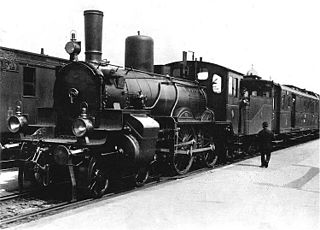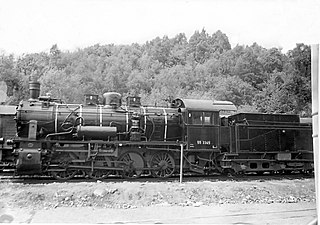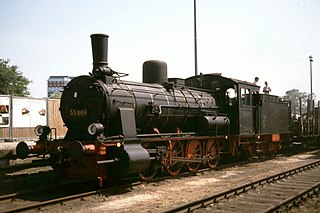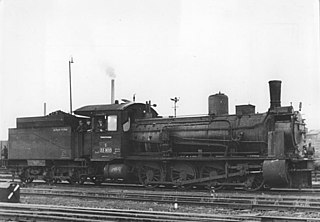
The Prussian Class S 3s were saturated steam locomotives developed by Hanomag for the Prussian state railways and were built from 1893.

The Prussian G 8.1 was a heavier, stronger development of the G 8 and was initially referred to as a 'strengthened standard class'.

The Prussian T 18 was the last class of tank locomotives developed for the Prussian state railways. They were originally intended for services on the island of Rügen as replacements for Class T 12 and T 10 engines. They emerged when a class of locomotive was conceived in 1912 that was to handle express and passenger trains in border areas or in shuttle services on short routes. A tank engine design with symmetrical running gear was envisaged because, unlike a tender locomotive, it could run equally fast forwards and backwards and could be operated on return journeys without having to be turned on a turntable. Its power and top speed were to be the same as those of the P 8. Robert Garbe designed this 4-6-4 (2′C2′) tank locomotive for 100 km/h with a 17-ton axle load and contracted the Vulkan Werke in Stettin to build it. It was given the designation T 18.
The Alsace-Lorraine Class G 8.1 was a superheated, goods train, steam locomotive with four driving axles, and was based on the Prussian G 8.1. There were no design differences between the two. The Imperial Railways in Alsace-Lorraine received a total of 137 G 8.1 engines between 1913 and 1919, of which eleven were built by Henschel and the rest by the Grafenstaden. They were numbered 5151 to 5278.

The Prussian G 10 was a German goods train, steam locomotive, whose design was based on a combination of the running and valve gear from the Prussian T 16 and the boiler from the Prussian P 8. In developing the G 10, however, the T 16 running gear with side play on the first and fifth axles was modified. The T 16 was also subsequently built with this modified configuration and called the Prussian T 16.1. The G 10 was intended for heavy goods train duties on main lines, but as a result of its low axle load it could be employed more flexibly than its equally powerful cousin, the Prussian G 8.1. The G 10 was occasionally even used in passenger train service.
The Prussian T 13 was a series of tank locomotives built in large numbers for the various German state railways, notably the Prussian state railways, and the Deutsche Reichsbahn during the early part of the 20th century.
The Prussian G 12.1 was a German steam locomotive built for the Prussian state railways during the First World War and was the largest Prussian freight locomotive with a 2-10-0 wheel arrangement. It had three cylinders, the two outer ones driving the third axle and the inner one the second axle.

The Prussian T 16.1 locomotives were built for the Prussian state railways as goods train tank locomotives about the time of the First World War. Six examples were also procured by the Imperial Railways in Alsace-Lorraine.

In 1905 the Prussian state railways grouped six-coupled, medium-powered, goods train, tank locomotives into its Class G 3. In addition to standard locomotives, there were also 285 G 3s that were not built to German state railway norms, because they had been built, in most cases, before the foundation of the Prussian state railways.
The Prussian Class G 4 were German, six-coupled, goods train, steam locomotives with a boiler pressure of 12 bar, built primarily for the Prussian state railways. Classified by the state railway in 1905, they included 16 locomotives from the railway division of Mainz, that originally came from the Hessian Ludwigsbahn. These earlier locomotives were delivered between 1872 and 1896 and did not meet the Prussian norms.

The Prussian Class P 6s were passenger locomotives operated by the Prussian state railways with a leading axle and three coupled axles.

The Prussian Class G 7.1 engines of the Prussian state railways were German eight-coupled, goods train, steam locomotives.

The Prussian T 14s were German, 2-8-2T, goods train, tank locomotives operated by the Prussian state railways and the Imperial Railways in Alsace-Lorraine. They were later incorporated by the Deutsche Reichsbahn into their renumbering plan as Class 93.0–4.
The Prussian Class G 5.1 steam engines were the first 2-6-0 goods locomotives in Europe. They were developed for the Prussian state railways from the Class G 4 and a total of no less than 264 units of this class were placed in service in Prussia between 1892 and 1902. The twin-cylinder G 5.1 had been designed to raise the speed of goods trains on main lines. In addition, more powerful engines were needed for the increasingly heavy train loads. The locomotives, which were equipped with a compressed air brake, were used in charge of fast goods trains (Eilgüterzugdienst) and also passenger trains due to their impressive top speed of 65 km/h. The G 5.1 was fitted with inside Allan valve gear and the carrying wheels were of the Adams axle design. The engines were coupled with tenders of Class pr 3 T 12. In Prussian service they were renumbered in 1905 into the 4001–4150 range.
The Prussian G 5.5's were early German freight locomotives with a compound engine. Unlike the otherwise identical G 5.4 they had a leading Adams axle instead of a Krauss-Helmholtz bogie. The delivery of the G 5.5 in 1910 followed directly on from that of the G 5.4. A total of either 20 or 25 G 5.5 were built.

The Prussian Class T 12 is an early, German, passenger train, tank locomotive built for the Prussian state railways in large numbers. These locomotives were superheated variants of the T 11.

The Prussian G 7.3 was a class of 2-8-0 locomotives of the Prussian state railways. The third class of the G 7 series, they were intended to power heavy goods trains on steep inclines, on which the permissible axle load was not yet that high. This affected for example, the Paderborn–Holzminden and Betzdorf–Siegen routes.

The Prussian G 7.2 was a class of 0-8-0 tender compound locomotives of the Prussian state railways. In the 1925 Deutschen Reichsbahn renumbering plan, the former Prussian locomotives produced from 1895 to 1911 were given the class designation 55.7–13; while the former Grand Duchy of Mecklenburg Friedrich-Franz Railway locomotives were classified as 55.57.
The Prussian G 5.2 was a class of two-cylinder compound goods locomotive introduced in 1895. As with many Prussian locomotive design, simple and compound versions of the same type were built – in this case the G 5.2 was the two-cylinder compound version of the simple G 5.1. The compound locomotives were more economical and more powerful than the simple locomotives; they were more suitable for long streches with few stops. The newly introduced air brakes made it possible to use the G 5.2 on passenger trains, which the Prussian State Railways often did.
The Prussian G 4.2 was a class of compound 0-6-0 goods locomotive of the Prussian State Railways. It was a compound version of the G 3 and G 4.1 types by Henschel.











